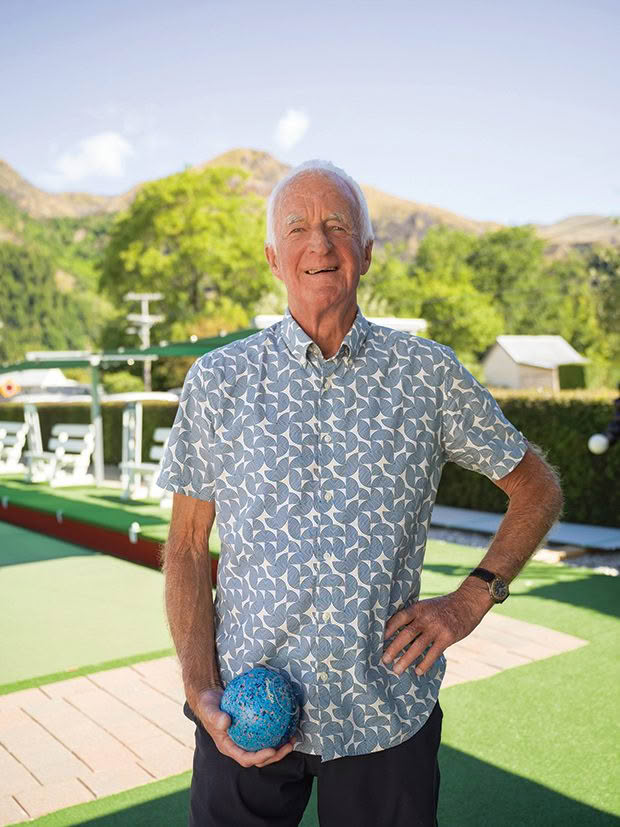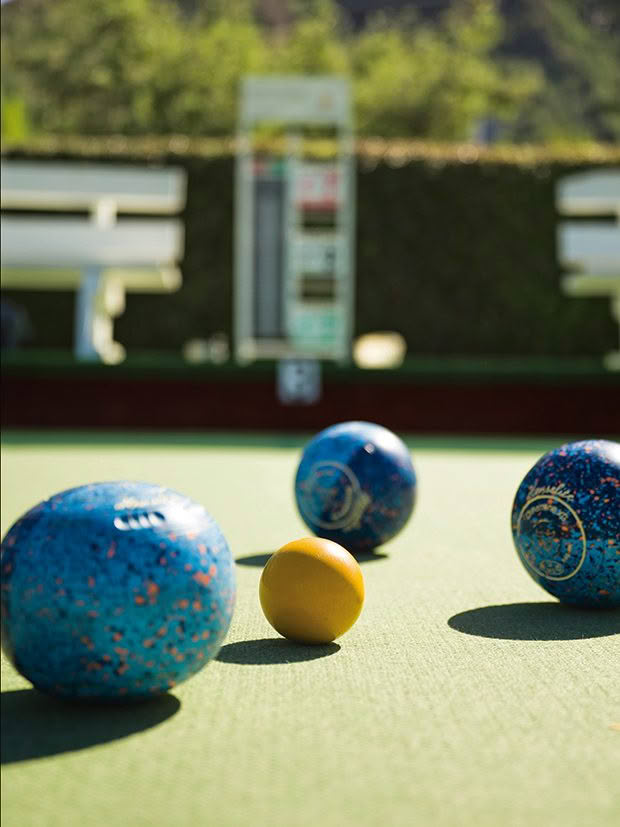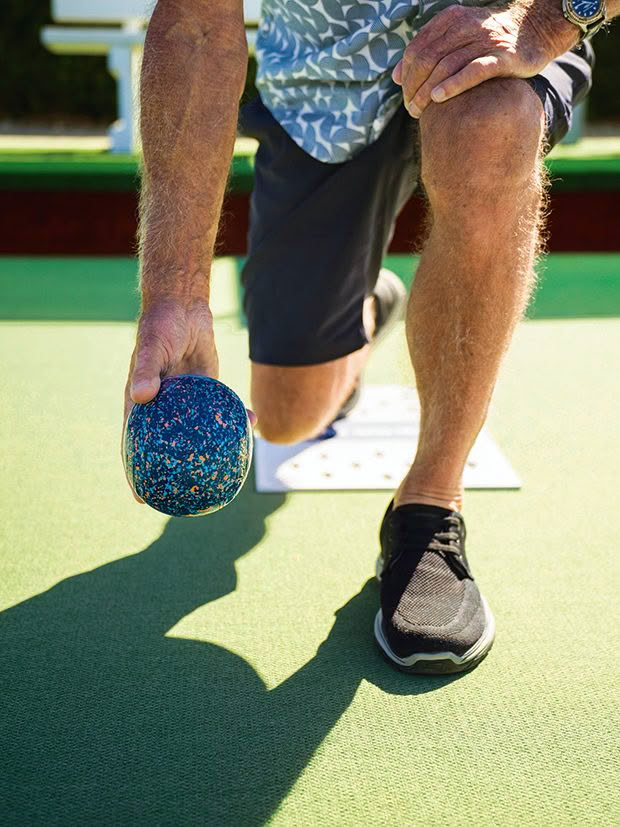From rugby journo to lawn bowls aficionado: The two sporting loves of Bob Howitt’s life

The sedate setting of a lawn bowls rink is a world away from the rugby grounds former sports journalist Bob Howitt used to frequent. He couldn’t be happier.
Words: Heather Kidd
Lawn bowls was never supposed to be Bob Howitt’s sporting love. Indeed, as a youngster growing up in Petone in the 1950s, his mother warned him off it: their neighbour played and imbibed at the local bowls club. He was a sore loser who became an ugly drunk.
Fast-forward 30 years to when Bob was one of New Zealand’s most renowned rugby journalists, the founding editor of Rugby News, a position he held for 26 years. Bob was a keen runner and touch rugby player, the game of bowls not on his radar. But that changed in the late 1980s when he married Jenny Harper, daughter of former All Black manager Ray Harper, a bowls fan.
Traditionally, the Harpers and their extended family gathered at their Arrowtown crib for the festive season, an annual event Bob happily embraced. Playing bowls was part of the holiday package. “Ray organised a family roll-up on January 1, before what was and still is three consecutive days of tournaments at the Arrowtown Bowling Club,” says Bob.
Bob enjoyed the experience, and his father-in-law was impressed, telling him he had a natural flair for the game. But the compliment wasn’t about to turn the rugby journo into a bowler. “I didn’t think I was old enough to play. Like most New Zealanders, I thought bowls was a sport for retirees and seriously old people, not for anyone in their prime.”
But fate had other ideas. The following day, one of Ray’s team was a no-show, and he persuaded his son-in-law to step in as a replacement. It could have been a disaster as Bob was still suffering the effects of a big night of partying and had to be dragged from his bed to play. Instead, it became one of his most treasured bowling memories: their team won the tournament. He was hooked.

“In bowls, it is essential to get two things right — weight and bias — although weight is really what it’s all about. Rather like putting in golf, it’s vital to get the weight right in whatever the conditions.”
For the next decade, Bob played intermittently, teaming up with Ray whenever time allowed — which wasn’t often given Bob lived in Auckland and travelled a lot overseas with work. Then in 2000, aged 59, he joined the Takapuna Bowling Club, a quick trip across the Harbour Bridge from his home in Herne Bay.
Within the first couple of weeks, Bob met another bowling newbie, Trevor Forward, and the two men became practice partners. They went on to represent North Harbour at development and representative level, winning the Takapuna pairs title seven times in nine years, including a record five wins in a row. Bob and Trevor were part of the seven-man Takapuna team that won the New Zealand interclub titles in 2005 and 2007, and in 2006, they were in the winning North Harbour development team. Bob teamed up with Madeleine Holland to win a mixed pairs North Harbour Centre title. He’s also won three centre fours titles, two with North Harbour and one with Central Otago.
Lawn bowls can be played as either singles, pairs, triples or fours, and Bob’s preference is pairs followed by fours. “The nice thing about pairs or fours is having a partner or partners. On days when things aren’t going right, you have them as support. Singles is good if you’re winning, but if things aren’t going right, it can be lonely. I don’t have the patience for it, although I have won Takapuna and Arrowtown singles titles.”
In 2016, Bob and Jenny quit Auckland for Arrowtown, where Bob became a mainstay of the Arrowtown Bowling Club. He is now the club’s tournament secretary, responsible for organising the three-day January tournament that began his bowling avocation.
But it’s not just on the rink where Bob has enjoyed considerable success. His prowess with prose has helped the clubs he’s been associated with to win charity grants of more than $500,000. “I’ve used my journalistic skills to try and make our applications stand out from the rest. I always include a cover letter presenting all the facts in less than 150 words.”
Up-to-date facilities are important because bowls is enjoying a resurgence. Numbers are increasing, and it’s particularly popular with those wanting a sport/social combination. Bowls New Zealand’s 2022 vision statement, “To be the best deliverer of sport into New Zealand communities,” appears to have hit the mark.
Although Bob is a dedicated and competitive bowler, he takes delight in seeing younger people giving the game a go. “The attitude of lawn bowls being an old person’s sport is changing. More younger people are playing; it’s amazing how excited they get about it. Time and again, I talk to bowlers who say they wish they’d taken up the game at a younger age, instead of waiting until their working career was over.
“If you get the basics right when young, you can play bowls all your life.”

HISTORIC SPORT
The origin of lawn bowls goes back centuries — a version of the game was reportedly played in ancient Egypt. Although Scotland is regarded as the home of the modern-day sport, it has been played in England since the 13th century.
Bowls has been enjoyed in New Zealand since the early 1860s. Initially, the sport was men-only but from the early 1900s, women set up clubs for themselves, often playing at men’s clubs on weekdays. The associations that ran the men’s and women’s games merged in 1996, and Bowls New Zealand has its headquarters in Auckland.
Bowls is played in more than 40 countries and has featured at 21 Commonwealth Games. Since the first games in 1930, New Zealand bowlers have won 13 gold medals across singles, pairs, fours and para events.
TIMES ARE A-CHANGIN’
Wearing white from head to toe was de rigueur for lawn bowlers for many decades. Women bowlers were obliged to wear below-the-knee-length dresses. The strictly enforced white-only clothing rule was anathema to many people. During the late 20th century, the rules relaxed and, these days, brightly coloured clothing is encouraged. The same applies to the bowls, originally known as “woods” because they were made from a dense wood, Lignum vitae, renowned as one of the hardest and heaviest in the world. Bowls were originally either black or brown but modern-day bowls, made from a hard plastic composite, are available in various colours, some with a fluorescent finish.
Love this story? Subscribe now!
 This article first appeared in NZ Life & Leisure Magazine.
This article first appeared in NZ Life & Leisure Magazine.
